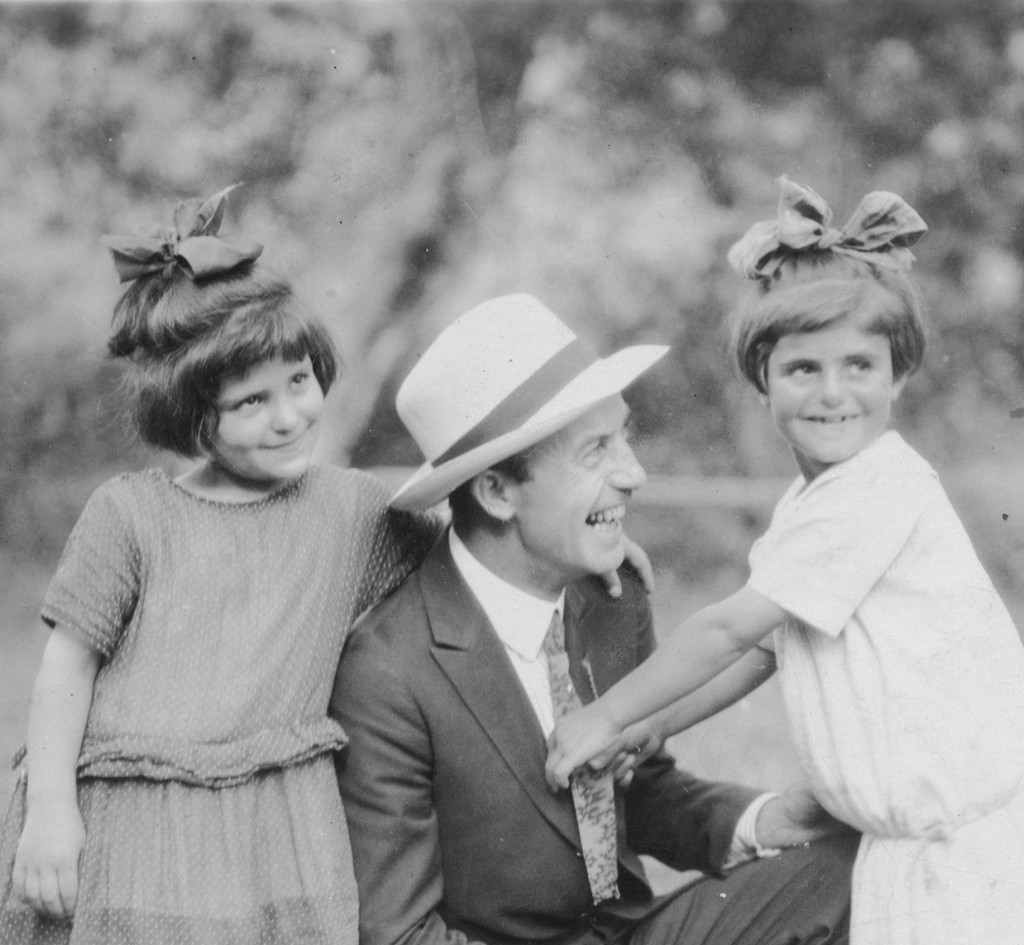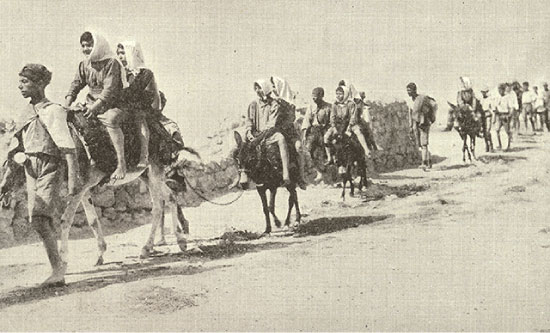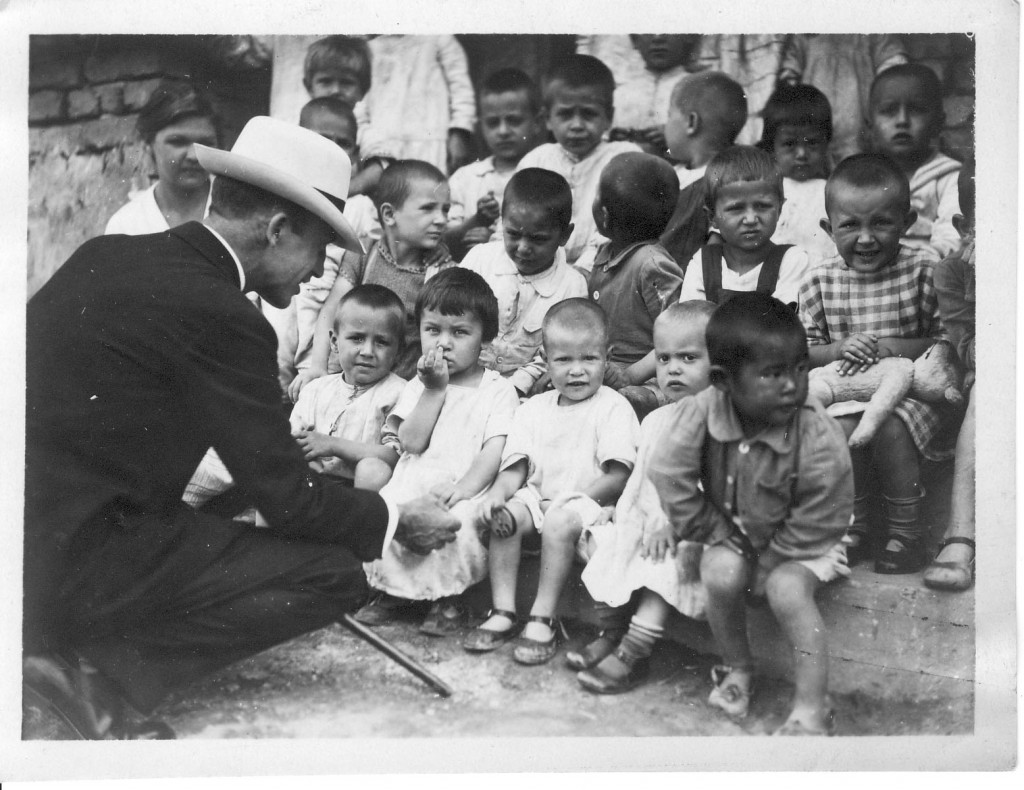“He loved us with all his heart”: Male Caretakers of Near East Relief

Barcaly Acheson with Babek and Lea, two of the children cared for by Near East Relief. He said his greatest achievement was "I made the children laugh."
There are countless fathers who suffered and died as a consequence of the Genocide who we remember. Today and every day, we express our gratitude for the countless male figures who stepped up during a time of crisis and great need, forming the Near East Relief, raising money across the US, and others who set sail to a land far away to serve as first responders, caretakers, and teachers for the hundreds of thousands of children who were left orphaned.

The Genocide began with the men. First fathers, uncles, sons and brothers were taken away as conscripts to labor in the Ottoman army or be massacred in isolation. Others were arrested and died in prison camps. During the deportations from the villages, adult men and boys over 15 years-old were separated from the rest of their community and killed. Those who survived were mostly elderly men, women and children, driven from their homes and denied the chance to pack anything to take with them.
“In the beginning the children were interspersed with the adults in the common refugee problem. They moved with the caravans of destitution or were buried by the wayside. They were fed a bowl of soup or given a crust of bread.” – James L. Barton
Upon receiving reports of the massacres and deportations in the fall of 1915, the American Committee for Armenian and Syrian Relief, later known as Near East Relief, was formed to provide emergency aid to the starving and displaced survivors. They were in desperate need of food, shelter, clothing and medical care. The most vulnerable and in need were children, many of whom were left parentless or separated from their families which made them especially vulnerable to exploitation as they struggled to survive without the protection of their families.

Near East Relief workers were sending reports home of the needs of the child survivors. In 1919 NER shifted the focus of its efforts to providing care for children from the refugee camps by organizing orphanages across the region.
Hundreds of men stepped up during a time of great need, including Barclay Acheson, Stanley Kerr, Joseph Kuenstler, Ray Travis and Sarkis Balabanian.

Barclay Acheson
Trained as an ordained minister, Barclay Acheson became the Associate General Secretary of Near East Relief in 1922. He spent that summer visiting orphanages and relief stations throughout the Near East. The experience left Acheson with a profound appreciation for fieldwork.
A year later he assumed the direction of all relief work in Greece, Syria, and the Caucasus. Acheson was based in Athens during the tumultuous population exchange between Greece and Turkey after the Smyrna disaster.
In November of 1925, as Director of Overseas Operations, Acheson prepared emergency evacuation plans for the 45,000 refugees and orphans in NER’s care in Syria as political unrest threatened the region.
Acheson sprang into action again the following year when a massive earthquake destroyed communities across the Caucasus region and severely damaged the orphan city at Alexandropol.
Acheson documented much of his time with NER on film, collecting photographs of his travels in Greece, Syria, Palestine and the Caucasus region between 1922 and 1928. Ranging from joyful pictures of laughing children to haunting portraits of refugees, these images capture the essence of Acheson’s life with Near East Relief. The collection shows that Acheson’s work was not just his career – it was his calling.
For more information on the critical work Acheson did and to see more of his pictures click here.

Stanley Kerr
When Near East Relief sent out a call for volunteers in 1919, Stanley Kerr responded and traveled to Aleppo where he set up a lab for typhus and malaria blood testing, photographed children for the organization’s records and acted as a “gatherer of Armenian waifs from Bedouin and Kurdish chieftains.” It is estimated that he and his colleagues rescued more than 450 girls in the area over just a few months. Kerr transferred to Marash in the fall of 1919 as the superintendent of relief work. In January of 1920 Marash was besieged by Turkish Nationalists. As the French colonial forces retreated, thousands of Armenians were massacred, and the American Hospital attacked. Kerr stayed hoping to shelter as many of the Armenian orphans and elderly as he could – a selfless decision that would save hundreds of children. He spent the rest of the winter feeding orphans and organizing a committee to manage food distribution.
Between 1920 and 1922, Stanley organized the evacuation of 1,400 orphans from Marash to Beirut, including hiring village chieftains to defend against bands of robbers waiting to ambush the caravans as they departed. By 1922 it was no longer safe to remain in Marash and Kerr left the city with the last caravan of orphans in July. The journey to Lebanon was long and difficult, southward from the city mostly on foot to the Baghdad Railway where the children were loaded on boxcars to Beirut. When they arrived, their clothing was cleaned, and the children bathed in the sea before being sent to their new homes in the orphanages around Beirut.

Kerr became director of Nahr Ibrahim orphanage in January 1923. By August, there were 1,000 orphans living there, all of them refugees from Turkey and many of whom the Kerr knew from Marash. He supervised the boys training in the trades, while his wife and fellow NER volunteer, Elsa Reckman Kerr, supervised their education. Tragically the orphanage was struck by a malaria epidemic in 1923, killing approximately 600 of the boys. The surviving children were transferred to Jubeil, and the Kerrs returned to the States where Stanley earned a Ph.D. in biochemistry. They came back to Beirut in 1925 as chairman of the Department of Biochemistry at the American University and raise a family with his wife Elsa.

Joseph Kuenstler
In 1922, Joseph Kuenstler was working for Near East Relief in southeastern Turkey taking care of Armenian orphans in Urfa. As in Aintab and Marash, withdrawal of the French colonial military forced thousands of resettled Armenians to flee the advancing Turkish nationalists for safety in Syria and Lebanon. Along with his wife Elizabeth, Dr. Kuenstler organized the evacuation of 8,000 orphans from Kharberd and the surrounding areas to Syria and Lebanon. They traveled by truck, rail, mule, camel and on foot. He spoke Arabic, Turkish, Armenian and Kurdish, among other languages, and his hard-earned reputation as a doctor as well as his diplomatic skills stopped many attacks as the caravans of children crossed the desert.

Affectionately known as “Papa Kuenstler”, Dr. Kuenstler served as the director of the NER orphanage in Ghazir from 1923 to the late 1940s. Kuenstler wanted to ensure the orphans would have the skills to support themselves, and he worked with Armenian master weaver Hovhannes Taschjian to establish a facility to teach more than 1,400 Armenian girls. The rugs they crafted were sold and donated for fundraising. One such rug was famously presented to President Coolidge in 1925.
While awaiting the birth of their first child, Dr. Kuenstler and his wife adopted an Armenian girl, Rose. According to his youngest daughter, Elibet, “He loved children. They were always climbing all over him. The kids just loved him, he always was there and took care of them.”

Ray Travis
Ray Travis led NER efforts in Aintab, remembered fondly as “a great giant of a man who enjoyed eating and playing with the orphans.” A veteran of World War I, Travis took up arms and secured weapons from the retreating French forces for the Armenian fighters. He ordered the cobblestones from the courtyard be dug up to be used to barricade the windows to protect the Armenians from the advancing Turkish irregulars. When finally forced to abandon Aintab, Travis arranged for the orphans to ride to the Aleppo train station on evacuating French military trucks.
Travis accompanied the orphaned refugees to Beirut, where he later supervised their care as the director at Jubeil. In his memoir Karnig Panian recalled “we also knew we would receive the best possible education. We would now have to work as hard as possible to rebuild our shattered lives.” The orphanage by the sea became home to 1000 boys, many of whom made the long journey from Aintab. Panian said of Travis “he loved us with all his heart, and he soon gained our confidence and friendship, becoming a surrogate father to us all.”
Sarkis Balabanian
Sarkis Balabanian was an Armenian from Aintab and became a math teacher at the NER orphanage. Balabanian is fondly remembered for bringing groceries and caring for the children in the orphanage, as well as fighting against the Turks. In his memoirs he tells the story of an orphan named Khntir who was being held against his will by a baker. He took the boy to the orphanage where he was adopted by the director, Mr. Merryl, and his wife. Many months later, after the orphans were evacuated from the city to Aleppo, Balabanian met a young woman who was looking for her son. It turned out it was the same boy Balabanian had rescued from the baker in Aintab, and the Merryls sent the boy to be reunited with his mother. Years later the boy returned to Aleppo to visit Balabanian. He had returned to Kharput to find a wife and was on his way home to America. In his memoir Balabanian remarked “Khntir revenged the Turks, by forming an Armenian family.”

As the children grew older and began to age out of the orphanages, they often helped one another find work and transition into the outside world. “Boys who have a position are always watching for an opening in their particular shop or place of employment for some other orphan boy.” Trained in a number of industries and apprenticing under local shop owners, the boys worked hard to save money. “As soon as he is making and earning even a mere pittance, he starts to reunite the broken fragments of his family and voluntarily assumes the financial burden.”
To support the continued work of the Near East Relief Historical Society, consider making a gift in honor or memory of someone who served as a father figure in your life.

Sources
Story of Near East relief (1915-1930) an interpretation
by James L. Barton
Lions of Marash
by Stanley Kerr
Bread from stones : the Middle East and the making of modern humanitarianism by Keith David Watenpaugh
Goodbye Antoura: A Memoir of the Armenian Genocide
by Karnig Panian
http://asbarez.com/163126/how-a-swiss-couple-saved-8000-orphans-during-armenian-genocide/
https://www.menschenrechte.org/blog/2005/02/23/im-lande-des-blutes/
https://www.bbc.com/news/magazine-32396459
https://armenianweekly.com/2017/05/23/honoring-balaban-hoja/

Barclay Acheson visiting an orphanage
